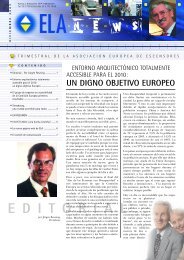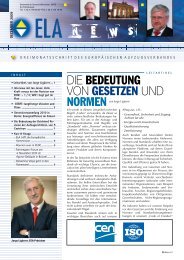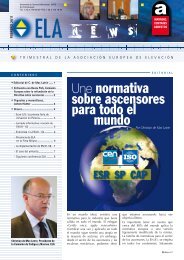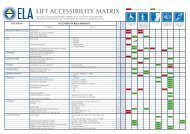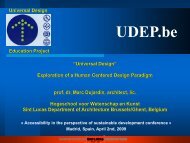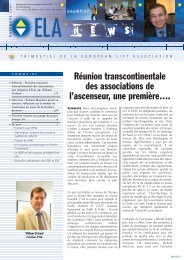WP6-Brochure-E4 brochure - ELA European Lift Association.
WP6-Brochure-E4 brochure - ELA European Lift Association.
WP6-Brochure-E4 brochure - ELA European Lift Association.
Create successful ePaper yourself
Turn your PDF publications into a flip-book with our unique Google optimized e-Paper software.
AC/DC<br />
Converter<br />
DC Link<br />
+<br />
Filter<br />
DC/AC<br />
Inverter<br />
(VSI or CSI)<br />
Motor Load<br />
d-q/i 1 ,i 2 ,i 3 i 1 ,i 2 ,i 3 /d-q<br />
Reference Position<br />
Reference Speed<br />
Reference Torque<br />
Field-oriented<br />
control<br />
Position, Speed<br />
Encoder<br />
Figure 3‐9. Block diagram of an induction motor‐drive system, with closed loop field oriented control (source: ISR‐<br />
UC)<br />
For this type of control it is necessary to use the dynamic model equations of the induction<br />
motor, based on the instantaneous currents and voltages, in order to control the interaction<br />
between the rotor and the stator, resulting in the flux and torque control.<br />
The attention of researchers has turned towards simplification, as well as the refinement of<br />
these quite sophisticated control methods. One issue was the desire to avoid the mechanical<br />
speed/position sensor needed with many of these control schemes. Electrical measurements<br />
are usually acceptable since the sensors can be placed anywhere, preferably inside the inverter<br />
cabinet, but a mechanical sensor is often undesirable because of space restriction or the added<br />
cost and complexity. Such arguments have particular weight with smaller motors. Of course, a<br />
certain loss of accuracy and dynamic response may be unavoidable when the speed sensor is<br />
omitted.<br />
Another important aspect is the acceleration process. As it can be seen in Figure 3‐10, if the<br />
motor is simply turned on (situation (a)), without any speed control, the rotor losses will be<br />
higher than with a pole changeable motor (situation (b)). A more efficient acceleration<br />
technique uses a VSD (situation (c)), that will significantly reduce energy consumption,<br />
comparatively to the other mentioned techniques.<br />
Figure 3‐10. Energy‐Consumption for an Acceleration Period: (a) Standard Motor; (b) Pole Changeable Motor; (c)<br />
Variable Speed Drive (VSD) (source: Siemens).<br />
Potential energy is constantly being transferred while the car is moving. If, for example, a lift is<br />
travelling down full (or up empty) the motor is actually being driven by the load and<br />
24





